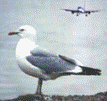Bird Strike Committee Proceedings

Bird Strike Committee-USA/Canada Joint Annual Meeting: 8th (2006)
Date of this Version
8-12-2006
Document Type
Article
Abstract
Habitat management techniques that reduce wildlife use of habitats on and around airports are critical for safe airport operations. Herbaceous vegetation comprises the main habitat type at airports and vegetation can be managed by various methods. The objective of this study was to compare bird and mammal use of grassland habitat managed either by mechanical (mowing) or chemical (plant growth regulator) methods. We monitored vegetation growth, plant community composition, and wildlife activity each week during May – October 2003 in study plots located in Erie County, Ohio. Vegetation was taller (P < 0.01) and denser (P < 0.01) in unmanaged plots than in managed (mowed or growth regulator) plots. Plots sprayed with growth regulator had lower forb/legume cover and higher grass cover than unmanaged or mowed plots. We observed more (P < 0.001) birds (× ± SE) per 5-minute survey on the ground in or perched on vegetation in unmanaged (3.0 ± 0.3) than mowed (1.5 ± 0.2) or growth regulator (1.5 ± 0.3) plots. More (P < 0.001) white-tailed deer were observed in mowed plots (4.3 ± 0.5) than either unmanaged (2.2 ± 0.6) or growth regulator (1.6 ± 0.3) plots. Fifteen small animals were captured in control plots, whereas no animals were captured in managed plots. Applying plant growth regulator did not maintain desired vegetation height and thus is not a costeffective alternative to mowing in plant communities of mixed composition. Managing vegetation height reduced wildlife use of grassland habitats. Removal of forbs and legumes by the growth regulator might explain the reduction in deer use in these plots. Reducing forbs and legumes might also make grasslands less attractive to small mammals. By simplifying herbaceous communities and encouraging plants less desirable to wildlife, it may be possible to reduce the attractiveness of airfields to wildlife species hazardous to aviation.

